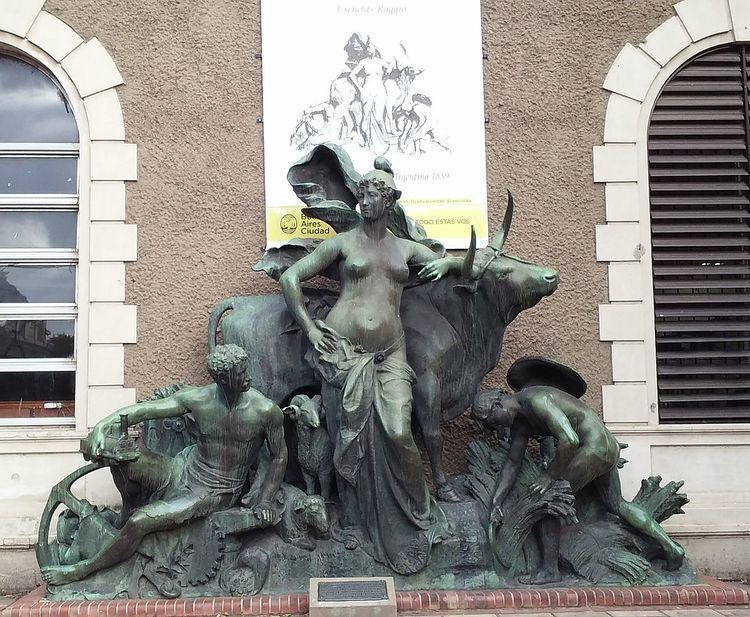Artist Jean-Baptiste Hugues | ||
 | ||
The Monument of The Argentine Republic is a sculpture by Jean-Baptiste Hugues, that was a central part of the Argentine Pavilion at the Universal Exhibition of Paris in 1889.
Contents
History
At the Paris World's Fair in 1889, 35 countries built enormous pavilions in where each nation showed its progress and cultural level. Each pavilion tried to represent the wealths of the nations participants. Argentina was one of the countries invited to the celebration, and this gave an opportunity for the political leadership, to show the economic strength of a State that had experienced major modernisation and transformation on the previous twenty years. The Argentine State pavilion was in the Champ de Mars, a privileged place because of its nearness to the Eiffel Tower that was constructed as the entrance to the Fair. The Argentine Pavilion was designed in a relatively European style, as compared to the Mexican and the Brazilian Pavilions, that emphasised their Latin American heritage. The Argentine Pavilion was designed by one of the best French architects of his time, Albert Ballú.
After the Universal Exhibition, the Argentine delegation in Paris tried to sell the Pavilion, because of the precarious state of the Argentine economy after the crisis of 1890. The pavilion was of iron, and could disassemble easily. When there were no buyers, it was decided to bring it to Buenos Aires. Some parts were lost in a storm during the transatlantic crossing, but it arrived in acceptable conditions to Buenos Aires. After bidding for the concession, it was used for diverse types of exhibitions. In 1910, at the centenary of the Revolution of May, the statue was recovered by the national government to be mounted at the National Museum of Fine arts. In order to place in on a square in front of the building, the Pavilion was disassembled between the years 1932-1934, and eventually sold as scrap. Today, already only it remains the sculptural group situated in the Technical School Raggio that represents to the Argentine Republic. In the year 1997, in the neighbourhood of Slaughterhouses –Andalgalá 1475-, found some remains of the Pavilion that served like seat of the ancient Factory Solana of Cars and Carriages. Recent investigations carried forward by a group of researchers of the FADU-UBA and, another of the Museum File Tecno Educational Lorenzo Raggio, found that the former owner, Isidoro Adrets, a soldier and a blacksmith, was the one who bought the remains of the Argentine pavilion in 1945. The patriotic symbols of the Argentine Pavilion were not destroyed, but buried in a sector of the Park 3 February in the neighbourhood of Palermo, in spite of that, until now there have been no efforts to locate and display them.
Description
The sculpture is a feminine figure that personifies the Argentine Republic, with a Phrygian cap (a traditional symbol of liberty) and garments waving in the wind. At her back is a bull that symbolises the active Argentine animal husbandry. At its feet are two human figures, aone the right, one that is harvesting grain (representing the agriculture and main source of wealth of the country) on the left to the left, a man seated on an anvil between gears (that it symbolises to the industry) holding a locomotive that personified the progress of a modern country. The sculptural groups of bronze that decorated the four corners of the Pavilion, were installed by the City of Buenos Aires in diverse points of the city. The main sculptural group was attached to the building of the Raggio Technical School Raggio (Argentina).
The maqueta
To build the Argentine pavilion in the universal exhibition of Paris of 1889, the national government delegated the tasks to organise a contest of projects in an ad hoc commission, chaired by the writer Eugenio Cambaceres. The bases specified a removable construction of iron, with the object to be able to move it to Buenos Aires once finalised the sample. The work was made by the architect Albert Ballu, winner of the second prize of the contest. Hughes esculpió a pediment melted in bronze. The National Museum of Fine arts conserves the original plaster model of the sculpture, measuring 84 cm x 122.3 cm x 33 cm. (National museum of Fine arts, inv. 6695). It was given to the museum in 1946 by Ignacio Pirovano, to commemorate his mother María Rosa Lezica Alvear of Pirovano. Dr. Pirovano had inherited the sculpture of his grandfather, Ricardo of Lezica and Thompson,who was a member of the Argentine commission of the exhibition in Paris.
